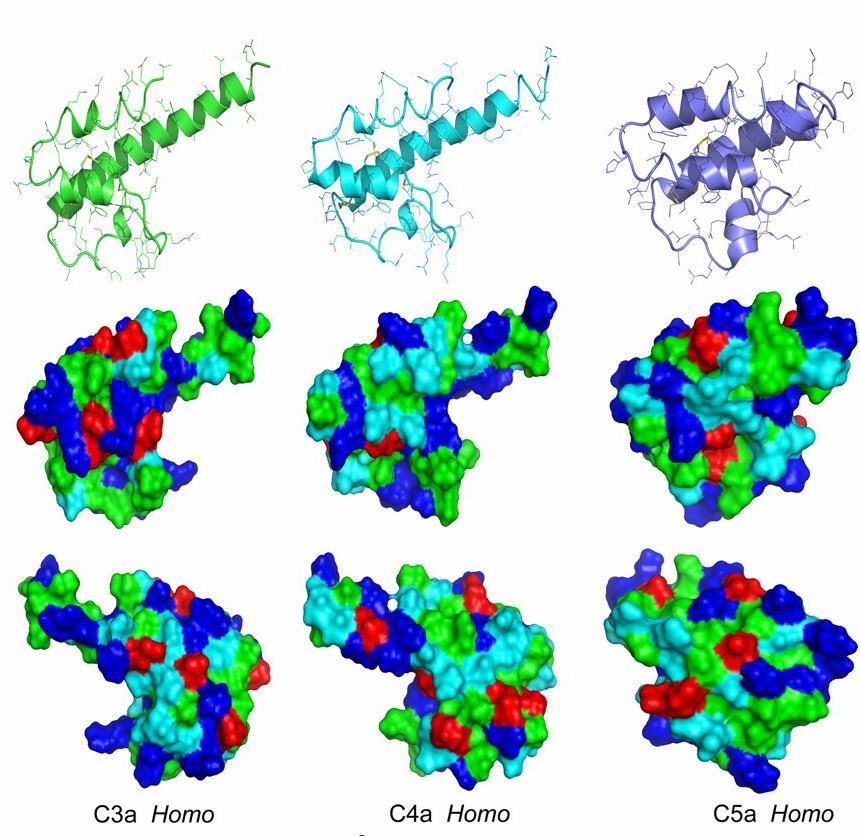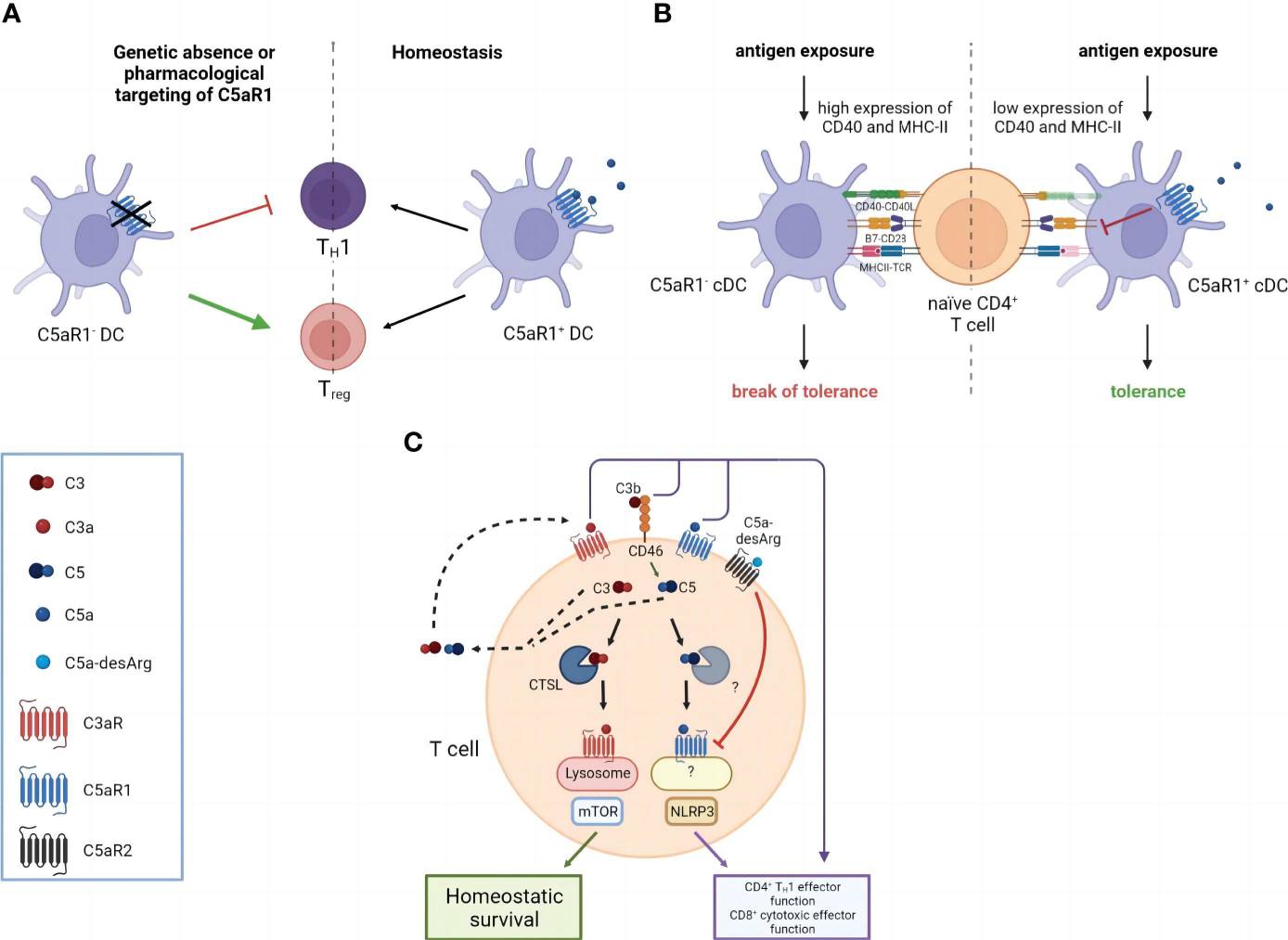What is an Anaphylatoxin? Structural Characteristics Biological Functions Anaphylatoxins Test Disease Associations
Complement anaphylatoxins—C3a, C4a, and C5a—are potent bioactive peptides generated during complement system activation. These molecules serve as critical mediators of immune responses, bridging innate and adaptive immunity while modulating inflammatory pathways. At Creative Biolabs, our two decades of expertise in complement therapeutics have positioned us at the forefront of research and innovation targeting these dynamic molecules.
What is an Anaphylatoxin?
Friedberger discovered that C5a, a cleavage fragment of complement C5, could be toxic to guinea pigs in 1910, so he called C5a anaphylatoxin. In 1967, researchers also found that C3 cleavage fragment C3a also has similar activity. Since then, in 1979, another weakly active anaphylatoxin C4a was also discovered. Therefore, there are three types of anaphylatoxin that have been found and confirmed, namely C3a, C4a and C5a.
 Fig. 1 Molecular models of human C3a, C4a, and C5a.1,3
Fig. 1 Molecular models of human C3a, C4a, and C5a.1,3
C3a, C4a and C5a are produced by cleavage near the N-terminus of the κ chains of complements C3, C4 and C5, respectively. They are all small molecular peptides, conformationally stable, pH resistant (pH 1-12), and heat resistant. These anaphylatoxins can bind to corresponding receptors on the surface of mast cells and basophils, stimulate cell degranulation, release active mediators such as histamine, and cause symptoms such as vasodilation, increased permeability, smooth muscle contraction, bronchospasm and other symptoms.
Structural Characteristics of Anaphylatoxins
Anaphylatoxins are active fragments produced by proteolytic cleavage of complement proteins C3, C4 and C5, with a highly conserved molecular architecture and a stable bioactive structure.
Table 1 Basic structural features of anaphylatoxins.
|
Structural Features
|
C3a
|
C4a
|
C5a
|
|
Amino acid composition and molecular weight
|
Consists of 77 amino acids, molecular weight about 9,089 Da, contains 6 cysteine residues forming 3 pairs of intrachain disulfide bonds (Cys22-Cys49, Cys23-Cys56, Cys36-Cys57), which gives it high stability.
|
Consists of 77 amino acids with a molecular weight of approximately 8,650 Da and contains an arginine residue (Arg77) at the C-terminus, the removal of which significantly reduces its activity. Its structure is similar to that of C3a, but its biological activity is weaker.
|
Consists of 74 amino acids, has a molecular weight of about 11 kDa, and also contains three pairs of intrachain disulfide bonds (Cys21-Cys47, Cys22-Cys54, Cys34-Cys55). The C-terminal arginine (Arg74) of C5a is essential for its chemotactic activity.
|
|
Secondary structure
|
Contains 40%-56% α-helix structure with almost no β-folding. Core region forms 3 antiparallel α helices (α1, α2, α3); N-terminal (residues 1-15) and C-terminal (residues 69-77) have flexibility.
|
Presumably homologous in structure to C3a, but with a more flexible α1 helix, resulting in significantly lower activity.
|
Structure similar to C3a, but with a slightly lower α-helix content, the N-terminal helix (α1) may be more flexible in the free state, and is conformationally stable when bound to the receptor.
|
|
Three-dimensional structure
|
The crystal structure shows a four-helix bundle folding pattern (α1-α4), with the core stabilized by a disulfide bond and the C-terminal arginine exposed on the surface, which is directly involved in receptor binding.
|
Similar to C3a, but with a longer C-terminal extension, forming a unique "helix-loop-helix" structure that enhances chemotactic activity.
|
Lacking clear 3D structural data, it is hypothesized that its core helix bundle is similar to that of C3a, but the difference in surface charge distribution affects receptor affinity.
|
In summary, the core features are as follows:
-
Conserved disulfide bonds: Six cysteine residues form three intra-chain disulfide bridges, stabilizing the core region essential for biological activity. Activity strength: C5a > C3a > C4a.
-
α-helical domains: Circular dichroism studies reveal 40–50% α-helix content, critical for receptor binding and signaling.
-
Receptor-binding motifs: The C-terminal pentapeptide of C3a/C5a directly interacts with G-protein-coupled receptors (C3aR, C5aR1).
Structural disruptions (e.g., disulfide bond cleavage) significantly impair activity, highlighting the importance of conformation in function.
Biological Functions of Anaphylatoxins
C3a, C4a, and C5a play multidimensional roles in innate and adaptive immunity by activating specific receptors and modulating immune cell activity. Their functional mechanisms can be categorized into the following core directions.
Innate Immune Modulation
Inflammatory mediator release
-
Mast cell/basophil granulocyte degranulation: by binding to C3aR/C5aR1 receptors, C3a and C5a trigger an increase in intracellular calcium ion concentration, leading to the release of inflammatory mediators, such as histamine and leukotrienes, which trigger vasodilation, increased permeability, and smooth muscle contraction.
-
Neutrophil activation: C5a induces the release of reactive oxygen species (ROS) and proteases (e.g., elastase), which enhance pathogen killing capacity while promoting NETosis.
Enhanced chemotaxis and phagocytosis
-
C5a is a potent chemokine for neutrophils, monocytes, and macrophages, and its concentration gradient directs the migration of immune cells toward the site of infection or injury.
-
C3a enhances regulatory phagocytosis of pathogens by upregulating complement receptors (CR1/CR3) on the surface of phagocytes.
Amplification of endogenous danger signals
-
Upon localized tissue injury, C5a promotes leukocyte adhesion and inflammatory cascade responses by activating endothelial cells to release P-selectin and IL-6.
Adaptive Immunomodulation
 Fig. 2 The anaphylatoxins impact on intrinsic T cell and DC-mediated activation.2, 3
Fig. 2 The anaphylatoxins impact on intrinsic T cell and DC-mediated activation.2, 3
Antigen-presenting cell (APC) regulation
-
Dendritic cell maturation: upregulation of MHC-II molecules and co-stimulatory molecules (CD80/CD86) by C3a/C5a promotes a lower threshold of T cell activation.
-
Cytokine polarization: C5a induces APC to secrete IL-12 and IL-23, driving Th1/Th17 differentiation; whereas C3a prefers to promote IL-10 production and suppress excessive inflammation.
Regulation of lymphocyte function
-
B-cell activation: C3aR signaling enhances B-cell survival and antibody class switching through the PI3K-Akt pathway, promoting high-affinity IgG production.
-
T-cell differentiation: C5a inhibits regulatory T-cell (Treg) function while promoting Th17 expansion through STAT3 phosphorylation, which is associated with autoimmune disease progression.
Table 2 Comparative functions.
|
Function
|
C3a
|
C4a
|
C5a
|
|
Chemotaxis
|
+
|
?
|
+
|
|
Smooth muscle contraction
|
+
|
?
|
+
|
|
Myeloid cell activation
|
+
|
-
|
+
|
|
Antimicrobial activity
|
-
|
+
|
-
|
Anaphylatoxin Test
Creative Biolabs is one of the world's largest suppliers of complement testing, providing customers with high-quality complement activation product test services from diagnostics to drug development. Complement activation products include split fragments after enzymatic cleavage of certain components, such as C4 (C4a and C4d), C3 (C3a and C3d), factor B (Bb), C5 (C5a).
Detection of complement anaphylatoxins usually involves a variety of experimental techniques to accurately assess its level and function in an organism. The following are some of the common assays:
-
ELISA: Use anti-neoepitope antibodies as capture antibodies to directly capture activated fragments without interference from inactivated components.
-
Flow Cytometry: Indirectly assess the activity of allergenic toxins by detecting the expression level of cell surface receptors.
-
PC Biosensors: Utilize photonic crystal technology to detect changes in cell morphology or adhesion, reflecting cell activation status.
-
Mass Spectrometry: Direct detection and quantification of the presence of allergy toxins by liquid chromatography-mass spectrometry (LC-MS) technology.
Pathophysiological Roles and Disease Associations
Anaphylatoxins are key mediators of immune defense under physiological conditions, but its excessive or dysregulated activation can lead to a variety of diseases. Its effects are bi-directional.
Table 3 Mechanisms of different anaphylatoxins in disease.
|
Disease
|
Key Anaphylatoxins
|
Mechanism of Action
|
|
Systemic lupus erythematosus
|
C3a/C5a
|
Promotes B-cell autoantibody production and breaks immune tolerance
|
|
Rheumatoid arthritis
|
C5a
|
Activates synovial macrophages to release IL-1β/IL-6 and drive joint destruction
|
|
ANCA-associated vasculitis
|
C5a
|
Induces neutrophil degranulation and release of proteases leading to vascular injury
|
|
Multiple sclerosis
|
C5a
|
Promotes reactive oxygen species (ROS) and TNF-α release, exacerbating demyelination and neuronal damage
|
|
Alzheimer's disease
|
C3a
|
Promotes microglia phagocytosis of synapses and accelerates cognitive decline
|
|
Asthma
|
C3a
|
Induces bronchial smooth muscle contraction and mucus secretion while upregulating Th2 cytokines (IL-4/IL-13), exacerbating airway hyperresponsiveness
|
|
Acute respiratory distress syndrome (ARDS)
|
C5a
|
Increases pulmonary vascular permeability, triggering alveolar edema and impaired oxygenation
|
Creative Biolabs pioneers innovative approaches to modulate anaphylatoxin pathways:
-
Receptor antagonists: C5aR1 inhibitors, C3aR blockers
-
Neutralizing antibodies: Anti-C5a monoclonal antibodies
-
Enzymatic inactivation: Rapidly degrades circulating C3a/C5a
Solutions Provided by Creative Biolabs Targeting Anaphylatoxin-related Diseases:
Creative Biolabs Provides High-quality Anaphylatoxin Related Products.
-
High-purity anaphylatoxin proteins: For in vitro assay development and drug screening.
-
Customized antibody production: Targeting C3aR, C5aR1, or specific anaphylatoxin epitopes.
If you want more information, please feel free to contact us.
References
-
Pasupuleti, Mukesh, et al. "Preservation of antimicrobial properties of complement peptide C3a, from invertebrates to humans." Journal of Biological Chemistry 282.4 (2007): 2520-2528. https://doi.org/10.1074/jbc.M607848200
-
Schanzenbacher, Jovan, Jörg Köhl, and Christian M. Karsten. "Anaphylatoxins spark the flame in early autoimmunity." Frontiers in Immunology 13 (2022): 958392. https://doi.org/10.3389/fimmu.2022.958392
-
under Open Access license CC BY 4.0, without modification.
For Research Use Only.
Related Sections:

 Fig. 1 Molecular models of human C3a, C4a, and C5a.1,3
Fig. 1 Molecular models of human C3a, C4a, and C5a.1,3
 Fig. 2 The anaphylatoxins impact on intrinsic T cell and DC-mediated activation.2, 3
Fig. 2 The anaphylatoxins impact on intrinsic T cell and DC-mediated activation.2, 3